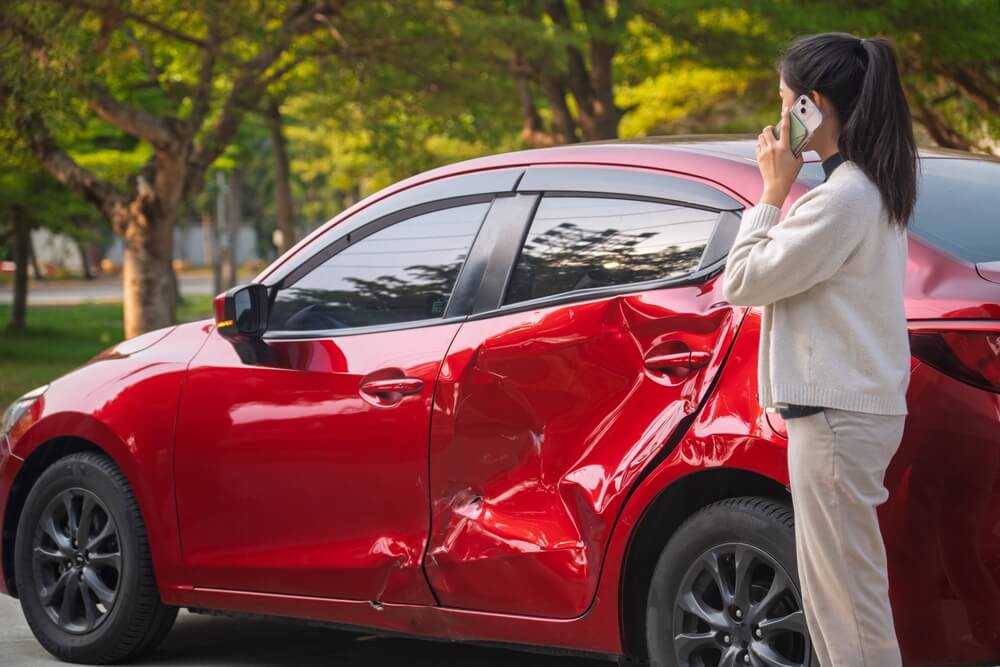
If you are not redirected within 30 seconds, please click here to continue.
Samedi: 10h – 16h HAE

If you are not redirected within 30 seconds, please click here to continue.
If you are not redirected within 30 seconds, please click here to continue.
83% of Canadians drive distracted despite majority agreeing it’s the biggest threat to traffic deaths: survey

- 83% of Canadian drivers engage in at least one distracted driving behaviour mentioned in the study, including activities like making a phone call on a hand-held device and eating while driving. And 43% engage in technology-related distraction, such as texting while behind the wheel.
- 58% of Canadians believe distracted driving is the biggest threat to traffic deaths compared to impaired driving, up from 47% in 2021 and 40% in 2020, yet engage in it anyway.
- RATESDOTCA data reveal that a distracted driving charge can lead to an increase in a person’s auto insurance premium — by 23% in Ontario and 18% in Alberta.
Each time you get in your vehicle, your phone is bound to come along for the ride. And while we should leave our devices in our pockets or in the front console, RATESDOTCA’s fourth annual distracted driving survey reveals 43% of Canadians admit to using an electronic hand-held device while driving. This includes using a geo-navigational app on an unmounted device (29%), checking messages while stopped at a traffic light (24%), and making a hand-held phone call (17%). All of these actions constitute an offence, which varies across provinces. But distracted driving takes many forms. Anything that robs your attention from the road can still yield fatal consequences.
When we consider the full scope of what it means to drive distracted, the percentage of distracted Canadians nearly doubles. A whopping 83% of drivers say they engage in at least one distracted driving behaviour, including eating, drinking, talking to a passenger, or reaching for an object while driving.
Despite the high volume of participation in distracted driving, the majority of drivers (58%) who participated in the survey believe distracted driving is the biggest risk on our roads. This number has only increased since our 2021 distracted driving survey (47%), marking a growing dissonance between thought and action when it comes to road safety in Canada.
Distracted driving isn’t just unsafe; it’s costly, too. Not only is there the fine you may receive from police — there’s also the toll this infraction can take on your auto insurance rate. Distracted driving can impact your auto premium differently from province to province. So, if your own safety, and the safety of others, isn’t enough of an incentive to stay alert while driving, it’s possible an auto premium increase might pave the way toward safer driving practices among Canadians.
Distracted driving transcends technology
Distracted driving is typically associated with smart phones, tablets, or screens of any nature — all of which constitute an infraction. But before hand-held technology, distracted driving still existed.
Activities that may seem harmless to engage in while driving, like searching for an object, eating, or drinking a non-alcoholic beverage, all divert your attention away from the road. Depending on the province you live in, some non-device-related behaviours can be a chargeable distracted driving offence. In Alberta and British Columbia, for instance, personal grooming counts as distracted driving. Whereas in Ontario, the province’s distracted driving law only applies to electronic devices. However, more than half (58%) of respondents believe eating or drinking a beverage while driving is a safe activity compared to technological distractions, especially using their mobile phone.

If drivers assume that non-technological distractions are less compromising, it's possible they may miscalculate the risk they’re taking when engaging in them. With 83% of drivers admitting to at least one distracted driving action on the full list included in the survey, most Canadians are (perhaps unknowingly) making themselves susceptible to both a collision and a ticket.
Fortunately, more Canadians are starting to recognize the risk non-technological distractions pose. For example, the number of respondents who believe eating or drinking coffee or water is safe while driving (58%) is down from 78% in 2021. Similarly, 28% now think reaching for an object while driving is safe compared to 57% in 2021. This could mean that the messaging around distracted driving is starting to sink in.
58% of Canadians say distracted driving is dangerous threat, yet do it anyway
More and more Canadians agree that distracted driving is a major threat to all drivers. So much so, that 58% of respondents now think distracted driving is the biggest cause of traffic deaths in the country, versus 47% in 2021 and 40% in 2020.
And they may be right. According to OPP data released in a recent CityNews article, inattentive-related traffic deaths have increased by 29% from 2020-2021, while alcohol-and drug-related traffic deaths declined by 46% in the same time frame. Yet, distracted driving persists.
There’s another kind of dissonance between perception and reality emerging from the data as well. Many Canadians partake in select distractions because they believe they’re safe. For example, many say they are likely to eat or drink coffee or water while driving (75%) and think it’s harmless, but the percentage of Canadians who text while driving (a more widely accepted form of distraction) and think it’s safe is much lower (23%). In reality, all of these behaviours are dangerous while driving. But a broader understanding of what constitutes distracted driving may be needed before drivers weigh each behaviour equally.
| Activity | % Likely to do activity while driving and think it's safe |
|---|---|
| Eat or drink coffee/water | 75% |
| Look at and talk to a passenger | 64% |
| Reach for an object | 44% |
| Check messages when stopped at a traffic light | 53% |
| Use geo navigational apps on an unmounted hand-held device | 50% |
| Make phone calls on a hand-held device | 44% |
| Text or instant message on a hand-held device | 23% |
| Watch a video on a hand-held device | 33% |
| Take a video on a hand-held device (e.g., blogging, TikTok videos, etc.) | 27% |
Alberta is the most distracted province, while Quebec is the least
Despite the fact that across Canada, a significant percentage of drivers are distracted behind the wheel, some provinces are further behind than others.
Alberta, for example, accounted for the highest levels of distracted driving, with 90% of respondents saying they engage in at least one activity from the full list and 58% of respondents saying they engage in at least one digital distraction activity. Yet, 50% of Albertans still think distracted driving is the main cause of threat to road deaths, more than impaired driving (39%). The penalties for distracted driving in Alberta include a $300 fine and three demerit points.
Comparatively, Québec saw the lowest percentage of people admitting to at least one activity on both the full list of distracted driving behaviours (73%) and the digital interactions list (36%). The province also ranked among the lowest in six out of nine distracted behaviours, particularly when it comes to technology-related actions like taking a video (3%), texting (9%), and checking messages while stopped at a traffic light (17%). This could be attributed to a recent road safety campaign initiated by the Sûreté du Québec and the distracted driving penalties already in place. The provincial police force has been cracking down on monitoring the main causes of death on the road, which include distraction, and plans to carry out its road safety plan until 2026.
Meanwhile, Ontario ranked third lowest, with 85% of Ontarians committing at least one distracted driving infraction from the full list of actions. If convicted of a distracted driving infraction in Ontario, the penalties you’ll face depend on your licence class and whether you’ve received a conviction before. You can receive a fine of up to $3,000, six demerit points, a 90-day licence suspension, or even a licence cancellation.
Use the table below to see which province ranks best and worst for each distracted driving behaviour by clicking the upward facing arrows.
| Province | Eat or drink coffee/water | Look at/talk to a passenger | Reach for an object | Use geo navigational apps on an unmounted hand-held device | Check messages when stopped at a traffic light | Make phone calls on a hand-held device | Text or instant message on a hand-held device | Watch a video on a hand-held device | Take a video on a hand-held device |
|---|---|---|---|---|---|---|---|---|---|
| Atlantic Canada | 73% | 64% | 60% | 19% | 24% | 15% | 12% | 4% | 3% |
| Quebec | 59% | 41% | 31% | 25% | 17% | 18% | 9% | 5% | 3% |
| Ontario | 68% | 63% | 56% | 31% | 26% | 16% | 11% | 5% | 4% |
| Alberta | 77% | 65% | 60% | 37% | 33% | 19% | 13% | 6% | 3% |
| Manitoba/Saskatchewan | 78% | 65% | 65% | 33% | 29% | 21% | 21% | 8% | 10% |
| British Columbia | 62% | 61% | 51% | 27% | 19% | 14% | 9% | 6% | 5% |
How distracted driving can increase your auto insurance rate
Distracted driving not only puts your life on the line, but your driving record, too. For those who think distractions are relatively harmless while driving, a look at the financial impact on your auto insurance premium might make a stronger point.
We used the RATESDOTCA auto insurance quoter to compare the lowest rate someone in Ontario and Alberta could get on our site with a clean driving record versus having one distracted driving charge under their belt. In both provinces, the driver’s annual premium increased.
"Auto insurance providers base premiums on an assortment of risk factors including a consumer's driving record. Distracted driving is risky and increases the chance that a driver can get into a fatal accident,” says Tanisha Kishan, RATESDOTCA expert and chartered insurance professional. “Getting a distracted driving ticket will therefore lead to higher premiums to cover that risk."

In Ontario, a 30-year-old male driver living in downtown Toronto with a clean driving record saw their $2,526 annual rate increase to $3,119 after committing a distracted driving offence, which marks a 23% increase.
In downtown Calgary, Alberta, the same driver with a clean driving record paying $2,474 annually had their lowest rate increase by 18%, to $2,929 a year.
The long-term effect of a distracted driving infraction on your auto insurance rate should not be overlooked. Whether you have a clean driving record or a history of traffic tickets you’re trying to clear from your record, shopping around for car insurance can ensure your next auto quote is as low as possible. But driving without distraction is the best thing you can do to keep it that way.
Methodology
The fourth annual distracted driving survey was conducted online by Leger between March 4 and 6, 2022. The survey included a sample of 1,633 Canadian respondents from Leger’s online panel of approximately 400,000 members. No margin of error can be associated with a non-probability sample (i.e. a web panel in this case). For comparative purposes, though, a probability sample of 1,633 respondents would have a margin of error of ±2.4%, 19 times out of 20.
Manitoba and Saskatchewan data were bundled to account for small individual sample sizes.
Parameters used for driver quotes:
- 30-year-old male (DOB: Jan 4, 1992)
- Single, employed
- G licence (or Class 5 in Alberta)
- Living in downtown of major city (Toronto, M4L 2R6 and Calgary, T2P 2A6)
- 2021 Honda Civic EX 4DR (financed)
- Purchased vehicle in Feb 2022
- Personal use
- Winter tires
- Street parking
- Insured consistently since 2008
- With current insurance company for two years
- Drives 10 kilometres daily to and from work
- Drives 15,000 kilometres in a year
- Comprehensive and collision coverage
- Policy to start April 2022
- No policy cancellations; no time without insurance coverage; clean driving record (i.e. no tickets in last 3 years)
- No discounts selected for UBI, bundling, CAA, or soft credit check in AB
Don't waste time calling around for auto insurance
Use RATESDOTCA to shop around, and compare multiple quotes at the same time.
Get money-saving tips in your inbox.
Stay on top of personal finance tips from our money experts!









